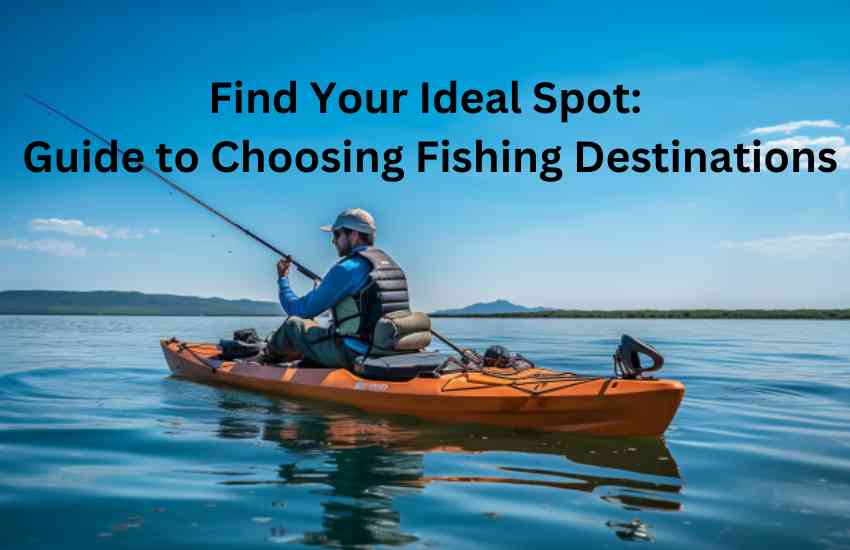8.1Find Your Ideal Spot: Guide to Choosing Fishing Destinations

Guide to Choosing Fishing Destinations
Understanding the Need for Discovery
Every angler yearns for that “aha” moment when they stumble upon a fishing spot that seems to hold secrets only they can unlock. It’s not just about catching fish; it’s about connecting with nature, the thrill of exploration, and crafting unforgettable stories to share. But how do you find these treasure troves? It all begins with diligent research.
Research Methods and Tools
- Online Forums and Communities: Join kayak fishing forums and online communities. Engage with experienced anglers who share insights into their favorite spots.
- Local Fishing Reports: Read local fishing reports to stay up-to-date with current conditions, species behavior, and the best times to fish.
- Nautical Charts and Maps: Delve into nautical charts and maps to identify potential hotspots, underwater structures, and depth changes.
- Satellite Imagery: Utilize satellite imagery to spot potential fishing spots, shallow areas, and potential baitfish concentrations.
Unveiling the Hidden Treasures
When researching, keep your target species and fishing style in mind. Are you aiming for bass, trout, or maybe even something more exotic? Here are some golden nuggets to consider:
Species Behavior and Habitat Preferences
- Learn about your target species’ feeding habits, breeding seasons, and preferred habitats.
- Identify features like drop-offs, underwater vegetation, and submerged structures that attract fish.
Local Tips and Insights
- Tap into the knowledge of local anglers who understand the nuances of the area.
- Discover hidden access points that may be off the beaten path and less crowded.
Weather and Seasonal Patterns
- Understand how weather patterns influence fish behavior and movement.
- Adapt your fishing strategies to different seasons – spring, summer, fall and winter.
Documenting Your Journey
As you embark on your research journey, don’t forget to document your findings and experiences. Whether through journaling, photography, or videos, capturing these moments not only helps you remember the details but also enriches the wider kayak fishing community.
Captivating Visuals
Use images of your potential fishing spots as teasers. A picturesque sunrise over a serene lake or the shimmering reflection of a kayak on calm waters can ignite excitement in fellow anglers.
Your Story Matters
Share anecdotes from your research expeditions. How did you stumble upon a hidden cove with the promise of abundant fish? What challenges did you face while navigating uncharted waters?
Embrace the Journey
Remember, the joy of kayak fishing lies not just in the catch but in the pursuit itself. The anticipation of discovering a new fishing spot, the thrill of paddling into uncharted territory, and the satisfaction of sharing your findings with fellow enthusiasts – these elements make the research process a captivating adventure of its own.
Previous Articles:
- Unlocking Kayak Fishing Secrets: Exploring the Essentials of Kayak Fishing
- Navigating Waterways Safely: Essential Kayak Fishing Safety Measures
Choosing the Right Fishing Spot: Key Factors for Success
Understanding the Water Conditions
Water Temperature: Fish are creatures of habit, and their behavior is greatly influenced by water temperature. Different species have preferred temperature ranges for feeding and activity. Research the typical water temperatures for the fish you’re targeting and choose locations where the water falls within their preferred range.
Water Depth: Different fish species thrive at various depths. Some prefer shallower waters near the shore, while others are found in deeper areas. Consider the depth of the water and the fish you want to catch when selecting a fishing location.
Underwater Structures: Fish often congregate around underwater structures like reefs, rock formations, and drop-offs. These structures provide shelter, hiding spots, and access to prey. Research the underwater topography of potential fishing spots to identify these hotspots.
Assessing the Habitat
Food Sources: Fish follow their food sources. Research the types of prey available in the area and choose locations where these food sources are abundant. This will increase the likelihood of finding active fish.
Cover and Shelter: Fish seek shelter from predators and strong currents. Look for areas with natural cover like submerged vegetation, fallen trees, and rocky outcrops. These locations are likely to attract fish seeking refuge.
Spawning Grounds: During spawning seasons, fish migrate to specific areas to reproduce. Knowing the spawning patterns of your target species can help you identify prime fishing spots during these times.
Considering External Factors
Weather Conditions: Weather plays a significant role in fish behavior. Changes in weather patterns can impact feeding habits and fish movement. Check the weather forecast before your fishing trip and be prepared to adapt your strategy based on the conditions.
Accessibility: Kayak fishing requires easy access to the water. Look for spots with safe launching and landing points for your kayak. Additionally, consider the distance you’ll need to paddle to reach productive fishing areas.
Regulations and Restrictions: Familiarize yourself with fishing regulations and any restrictions in the area you plan to fish. This includes fishing seasons, size limits, bag limits, and any special rules for certain species.
Putting Knowledge into Action
Armed with these insights, you’re better equipped to choose a fishing location that aligns with the preferences and behaviors of your target fish. Remember that fishing is an adventure, and the thrill often lies in the journey as much as the catch. By considering factors such as water conditions, habitat, and external influences, you’ll increase your chances of having a successful and rewarding kayak fishing experience.
Previous Articles:
- Article on Understanding Fish Behavior & Habitats: [Link Here]
- Article on Essential Gear & Safety Precautions: [Link Here]
(Alt text for image: A serene lake with a fishing kayak and angler in the foreground, surrounded by lush greenery and calm water.)